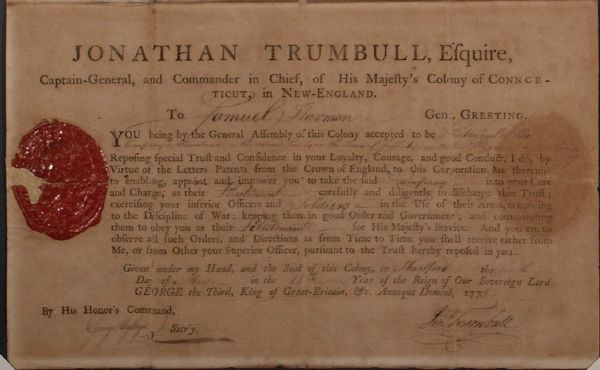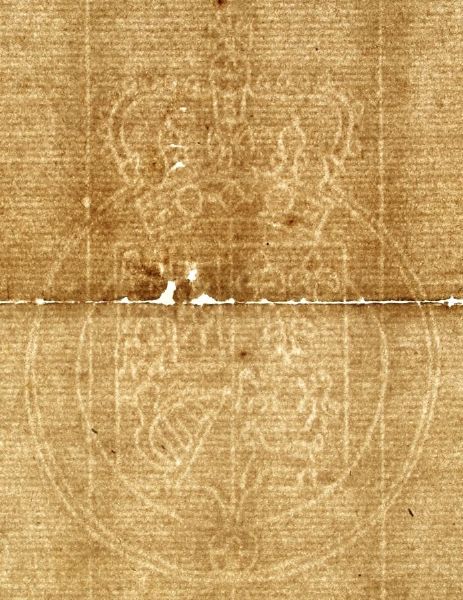Just yesterday I got back from conservation and framing a commission in a colonial militia given to one of my wife’s ancestors at the outbreak of the American Revolutionary War. The commission is typeset with blanks filled in by hand.

I give the whole text here [filled-in portions, as opposed to typeset boilerplate, are in brackets]:
JONATHAN TRUMBULL, Esquire, Captain-General, and Commander in Chief, of His Majesty’s Colony of CONNCETICUT [sic, typo], in NEW-ENGLAND, To [Samuel Harmon] Gent., GREETING.
You being by the General Assembly of this Colony accepted to be [Lieutenant of the Company or Trainband in the Second Society in the Town of Suffield in the First Regiment in the Colony] Reposing special Trust and Confidence in your Loyalty, Courage, and good Conduct, I do, by Virtue of the Letters Patents from the Crown of England, to this Corporation, Me thereunto enabling, appoint and impower you to take the said [Company] into your Care and Charge, as their [Lieutenant] carefully and diligently to discharge that Trust; exercising your inferior Officers and [Soldiers] in the Use of their Arms, according to the Discipline of War: keeping them in good Order and Government; and commanding them to obey you as their [Lieutenant] for His Majesty’s Service. And you are to observe all such Orders, and Directions as from Time to Time you shall receive either from Me, or from Other your Superior Officer, pursuant to the Trust hereby reposed in you. Given under my Hand and the Seal of this Colony, in [Hartford], the [Sixth] Day of [May] in the [15th] Year of the Reign of Our Sovereign Lord, GEORGE the Third, King of Great-Britain, &c. Annoque Domini [1775].
[signed Jon:thn Trumbull]
By His Honor’s Command [signed George Wyllys] Secr’y.
The irony here is that this commission for “His Majesty’s Service” dates from May of 1775, when Connecticut and the other New England colonies were feverishly swelling their town companies and colony regiments in response to the outbreak of hostilities around Boston — to defend the colonies against the regulars. At this time, however, many still felt themselves loyal to the crown but betrayed by the legislators and officials responsible for the various burdens deemed unjust in the colonies.
In addition to the obvious ironies in the boilerplate used here, there is the added touch that the paper for the commission has a watermark of the royal arms—I had not realized this until the conservator had it on a light table. They are the standard Hanoverian version of the arms; though the fourth quarter is rather crude, with just one lion passant for Braunschweig, an OK rampant lion for Luneburg, and beneath them a rather sorry horse which looks more like Lascaux than Westfalia.

I’m guessing that a cache of paper watermarked with royal arms was kept by colonial officials for such official papers as these commissions. But perhaps royal-arms-watermarked paper was ubiquitous and commercially available? I haven’t checked it yet in Briquet’s (Les filigranes).
Unfortunately the ‘seal of the colony’ of Connecticut (a handsome blob of red wax) is mostly intact, but dessicated, somewhat flattened from long storage in a pocket, and very indistinct. The seal is supposed to look like:


2 Trackbacks/Pingbacks
[…] Another amazing artifact from the Connecticut Harmons which has now come our way. They lived in Suffield, Connecticut. Cynthia’s grandfather Samuel Harmon was the militia lieutenant whose commission was also given to us last year; now these hang together. Cynthia died at age 21 and is buried in West Suffield. Her brother James Hezron Harmon (see his daguerreotype here) must have passed down his sister’s sampler. […]
[…] also bears a fine British crown watermark (similar to the one on my wife’s ancestor’s colonial militia commission) which shows the paper may well have been made under contract for use in colonial courts or by […]
Post a Comment